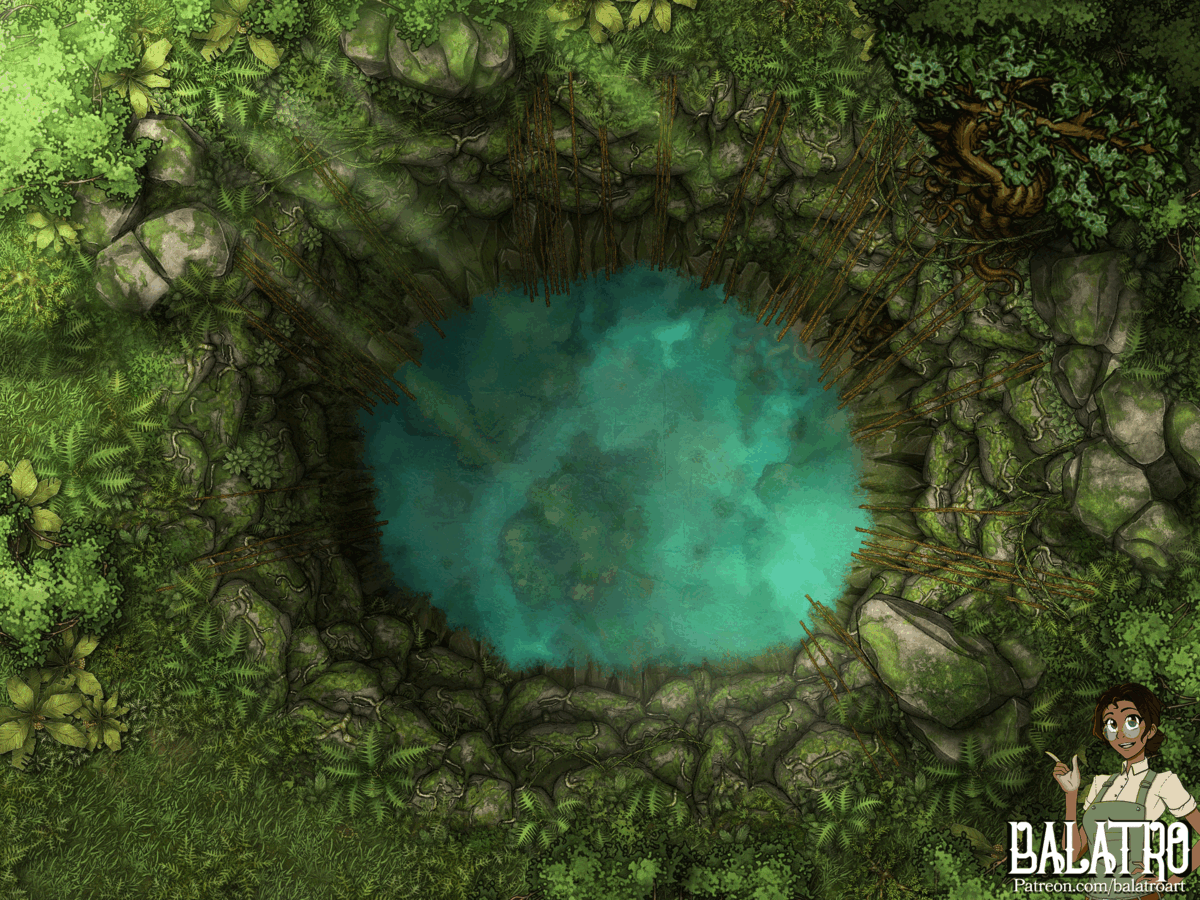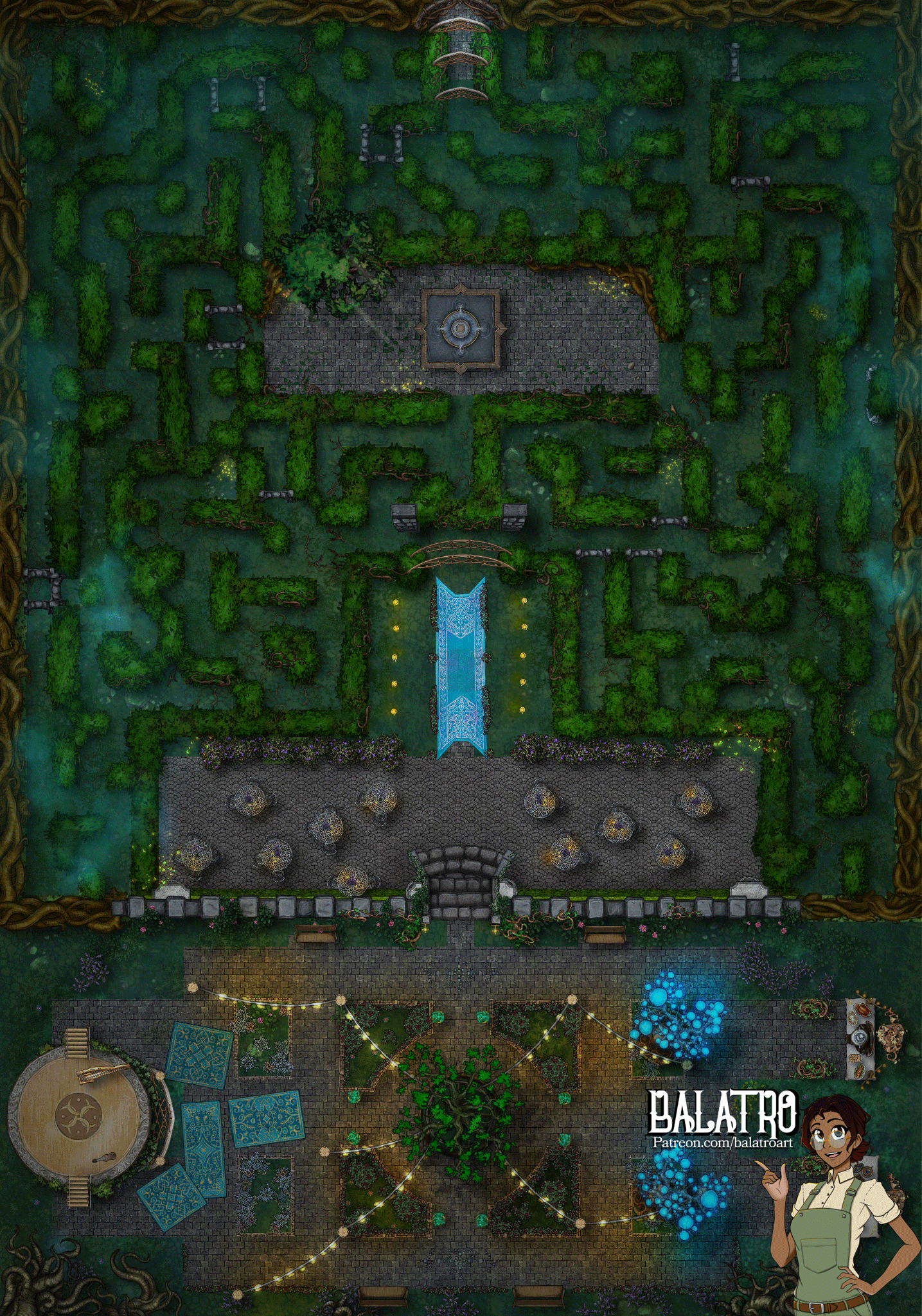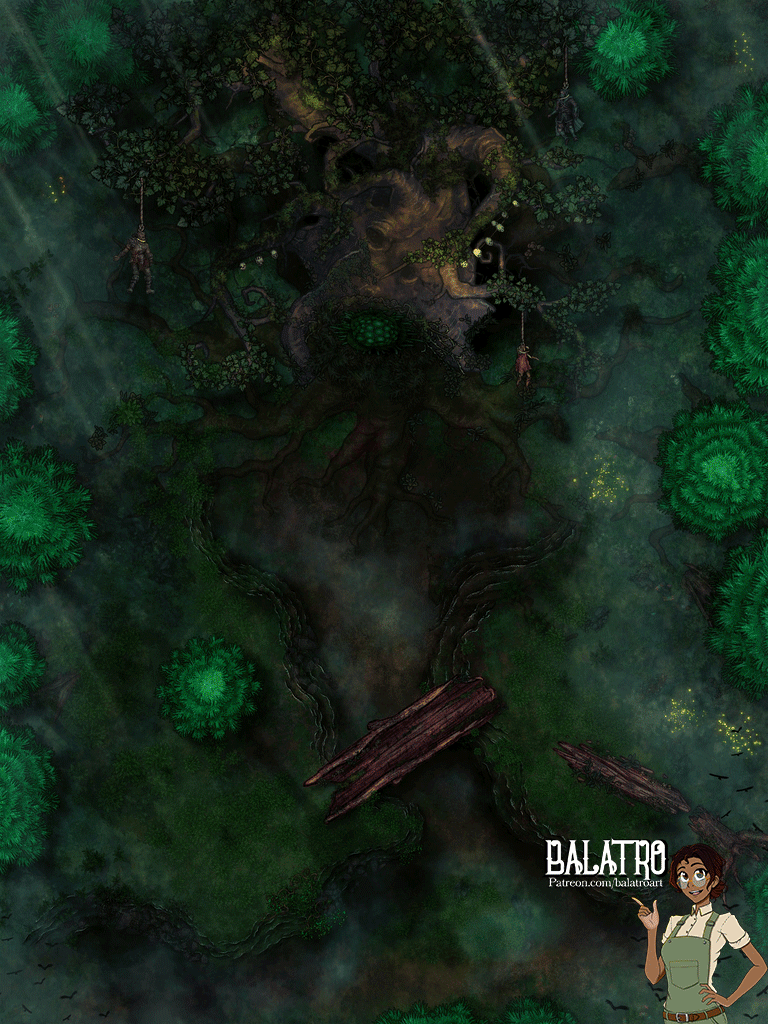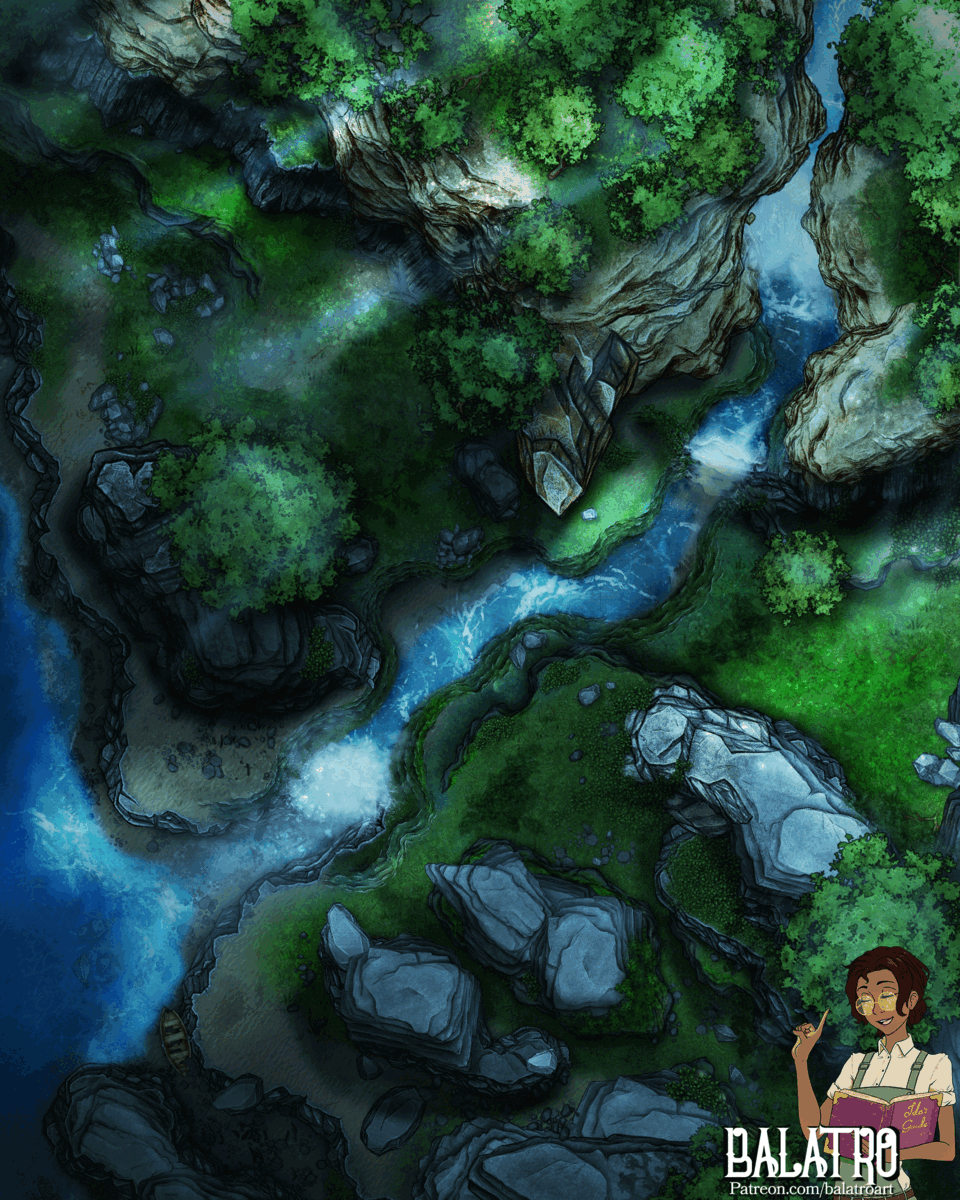
The hidden realm of Beasts
Wilder
Wilder is not a place for man. It is a savage, untamed haven for beasts—a realm that demands respect for the ancient powers of the land. Ruled by the quasi-deity Hazradorf, the Red-Eyed King, and his five daughters, the Sister Dryads who each embody a season, Wilder is a land of harsh truths and fragile beauty. when the rabbit escapes the snare, and the hunted deer vanishes behind a tree— Wilder is where they go. spirited away to safety.
It is the hollow at the back of the burrow of the world, a hidden refuge known only to beasts. A place outside of maps and memory, where the wild things go when they can go no farther. Wilder is the secret haven to vanish away from man at the deepest depths of every wood.
Battlemaps set in this location
Sharl
An isolated valley boxed in on three sides by mountains, with an open drop into the oblivion below Baanjax. Home to the fairy, Sharl is a misty, mysterious place with towering trees whose wide canopies and giant orange leaves ward off the Saltash of Cinnosom from the nearby Ashenwood. Below, the world is strange and still. The trunks of massive trees rise into the mist like pillars holding up the sky.
The landscape is rocky and tangled with large, twisting roots between dark ponds that are filled with vibrant and skittish coy. Scattered among them are small fairy villages, their doors carved directly into the trees. These settlements are broken up by little creeks crossed with tiny bridges that flow toward the edge of Wilder. The villages are easy to spot, as the dimly lit forest floor makes the soft glow of their windows stand out like beacons.
Moteroot
At the jagged, broken edge where Baanjax meets Wilver, huge, broken-tooth mountains stab upward into the sky. Between each peak a shower of plant life pours out from the Fey realm into the darkness below like a waterfall. The roots grow until they become too heavy, breaking and falling into the abyss—only to be replaced with supernatural speed by the ever-overgrown Wilder.
This constant cycle of rot and renewal, repeated over countless ages, has made Moteroot an extremely volatile and untraversable wilderness clinging to the edge of the world. Trees grow against the rock like vines on brick, and sometimes tear free, pulling huge mats of vegetation with them as they tumble into the void.
The Lake of Violets
An extremely salt-dense lake, known for the thick bushes of violets that grow huge and crowd every bank along its edge, even shooting up from the beds of dried salt crystals in the shallows.
The water of the lake is so saturated with the salt of Cinnosom that it’s nearly impossible to submerge anything in it. There is one exception, however: magical items sink. In fact, they become heavier the more powerful they are. It’s said the strongest artifacts drop like boulders of tungsten directly to the bottom—no power is great enough to retrieve them once they’ve sunk. The lake is believed to somehow scrub away magic itself, slowly washing away enchantments and leaving behind only simple, mundane objects, which then float back to the surface.
Rosecourt
The fabled home of the regal Rose Firbolg, Rosecourt is a tree shaped marble palace where families of florrum nobility dwell together in their absolute elegance. Its spiraling branch-like towers are draped in climbing ivy, and vast garden mazes stretch far beyond the palace courtyard. Any who wish to visit must first navigate the living labyrinth and reach its center to find the outermost gates.
The Rose Firbolg, like all of their kind, delight in throwing lavish balls and masquerades. These events are opulent even by Fey standards—supernaturally magnificent and indulgent.
The Ashenwoods of Cinnisom
Realm of the next eldest daughter of Hazradorf, the arch-dryad Cinnisom—patron of the season of salt, lightning, and ash. The Ashenwood is a land stained grey by ever-billowing plumes of saltash. The trees seem more like smoldering statues than living things caked in layer upon layer of grey.
The wood is home to the Cinderwhisps—drifting spirits of air that gather falling ash and salt to construct ember-eyed, physical bodies. These whisps carry coals and small fires within them like living furnaces, and they delight in wandering through the woods, starting fires wherever they go.
Flytrap
Firbolg, across their many tribes, are generally peaceful and noble people. But on the edge of Wilder, pressed up against the Soul Gate, there exists a tribe of barbarians. Known as the Flytrap florrum exemplus, this brutal culture of flower-folk takes its temperament to the father of the Fey—Hazradorf. They are violent, aggressive warriors who delight in little else besides battle.
Their society has no figurehead or formal hierarchy. The short and savage lives of its members leave little room for lasting leadership. Instead, they focus on quickly raising new warriors from the sprouting—rearing them fast and putting a hatchet in their hand.
The Frigidwood of Winter
The nearest point of Wilder to the skygiants’ realm of Algere, the Frigidwood is a forest locked in an endless blizzard. Twenty feet of snow blanket everything but the very tops of the trees. Mountains of ice rise from the frozen earth, their peaks jutting out like sharks’ fins through the endless white. These are the lands of the middle daughter of the Red-Eyed King: the Arch-Dryad Winter, for whom the season takes its name. Her domain, like her, is cruel and unfeeling. taking much, and returning little.
This wood has long become a refuge for Covens—humans who once betrayed their kind for the Red Eyed King. Fleeing persecution after dealing a devastating blow to mankind in the First War of Crudilex, their culture sought shelter in the winter wilderness. There, they struck a pact with the Arch-Dryad. In return for her protection, the witches offer generations of daughters to serve and safeguard her secrets, ensuring she remains a mystery befitting her season. They say that it is the witches who silence sound over fresh-fallen snow, and that in exchange for the hush no witch may die of cold in the winter months.
Among the ancient trees of the Frigidwood, the oldest of the Covens still endure. These settlements are tended by venerable hags, who pass on their history and the frost-bound spells of Winter to the young witches during their coming-of-age journeys.
Blooded Garden
At the outer edges of Winter lies a glade, just beyond the reach of the roiling, endless blizzard. Cold and perpetually dusted with fresh snow, stark and silent. Huge wooden poles rise from the banks, flying banners of deep red against a world of white. The Blooded Garden, home of the barbaric Blooded Horde fueled by fury and violence—immortal fey creatures who appear child-like, with antlers and feathered hair. Their deathlessness is tied to this place: when slain, they rise again from a bed of red flowers that bloom in the snow of the Blooded Garden. They are the personifications of nature’s brutality—a bestial need to hunt and kill.
Each Blooded has a twin: the Unblooded. Equal in form but opposite in soul, the prey the blooded endlessly hunt. These twins are eternally reincarnated across the glade, their cycle of rebirth locked in violent symmetry. One to kill, one to fall. One to rise, one to remember.
Unblooded Garden
At the edge of the Unknownwood of Autumn—where the leaves thin into bare patches and faint drifts of snow begin to gather—there lies a quiet valley filled with small orange blossoms. To the outsider, this place is unremarkable, easily overlooked. Unlike the Blooded Garden, marked by shamanistic flags and savage ceremony, the Unblooded Garden is the last place one would expect to find an Unblooded. And yet—like their hunters—they rise again in this glade, reborn in a bed of flowers.
But no Unblooded lingers here. Their killer knows this is where the trail begins anew. And so, with each rebirth, the Unblooded flees—never staying long enough to be caught, like a rabbit darting from the jaws of an angry hound.
The Unknownwood of Autumn
Realm of the eldest daughter of Hazradorf—Fall—this vast woodland is locked in a perpetual autumn: high winds, drifting leaves, and long, haunting nights. The Unknownwood is a labyrinth unlike the forests of her sisters. Fall does not easily release those who wander into the unknown.
Among the drying trees, countless strangers roam, seeking a way out— or forgetting there was an “out” to begin with. Traversing the Unknownwood is less of a physical journey. It's steeped in metaphor and emotion. Only those willing to grow, to change, to learn, or to confront their flaws may leave. Because if you’ve changed who you are as a person then the person who entered the Unknown, the one Fall claimed as hers, is no longer who you are and therefore Fall relinquishs her claim.
Stubbornness is a death sentence in the Unknownwood. To refuse transformation is to wander the unknown, forever.
Throne
Capital of Wilder and home of the Red-Eyed King, Hazradorf. Nestled at the bottom of a basin, flanked by mountains that lean inward like jagged fangs, lies a sprawling city of ten million tents. Throne is an energetic and powerful place—a nexus of all Crudilexian ley lines and the seat of ultimate druidic power. The name is as blunt and direct as the one who named it: Throne is Hazradorf’s stronghold, reinforced to withstand the inevitable war between man and beast that he foresees like a giant doomsday cult.
The kingdom itself sprawls within a half-covered cavern carved into the mountainside. Crude stone structures, supported by primitive wooden beams, fill every available space. The entire region is illuminated by hundreds of bonfires. Dens for various intelligent monsters dot the city; bones line the streets, and werewolves tear apart anyone foolish enough to disturb the fragile peace. Everything here operates with a savage efficiency.
The Rotwoods of Blight
Home to the youngest daughter of Hazradorf, the Arch-Dryad Briar, ruler of the season of Blight. Her realm is a soft-soiled expanse of carrion, mold, and undeath—a picture perfect representation of the natural processes surrounding the end of living things. Passing through the Rotwood is easier said than done. The soil sags beneath weary steps, trees ooze with rotting leaves, and the air is thick and putrid, buzzing with swarms of insects.
The many cesspits scattered throughout are cloaked in deceptive layers of moss and leaf litter that can easily collapse underfoot, dumping those who fall into deep pools of rotten compost. These pools teem with the animated bones of countless dead beasts who died inside. This place was not meant for the living; it is a land trapped in perpetual decay, the final stage of death. The Rotwood forms the perfect border to the Throne of Briar’s father, Hazradorf. Only those who seek and earn Briar’s blessing are likely to cross it unscathed.
The Wanderwood of Spring
Among the most central of the Sister Woods, Wanderwood is the realm of Spring—the Arch-Dryad daughter of Hazradorf and the living embodiment of the season that bears her name. Wanderwood is the most hospitable of the Sister Woods, blessed with perpetually pleasant weather and endless blooming growth. Its firbolg inhabitants take full advantage of this abundance, building thriving tribes and cities nestled within the bounds of the wood.
Boweswim of the Earth Eicio
Constructed at the strongest of all Terran ley line crossings, Boweswim is considered the capital of all the world’s Eicio, even those born of other ley lines. Mostly due to the fact that the settlement is the largest and most well established. The Terran ley line is by far the most abundant, and so there are simply more Earth Eicio than any others of their kind, allowing them the numbers needed to sustain a population the longest.
The settlement itself resembles a giant stone circle Stonehenge. It is formed of great, upside-down U-shaped monoliths that rise high into the air, their faces pocketed with carved windows and entrances leading into cave-like interiors. At the heart of the settlement stands a temple,
serving as the focal point for the Terran ley line energies. All the stone structures are tangled with dense vines and thick ferns, blooming and thriving in the eternal spring of the Wanderwood.
Boweswim is a welcoming city, offering service for service rendered. Those in need speak to the founder, an ancient Earth Eicio spiritual elder who resembles a humanoid willow tree. The elder listens to their request and assigns a task that fulfills some other need within the community—repayment through action, with no use for money or trade.
Aairnwood
Bordering Wilder and Lucanford, Aarinwood is home to the Aarin—forest creatures awakened by the divine pollen of the flowers known as Aarinlight. This woodland is the birthplace of Vaaribi, the goddess of humility, quests, and personal growth. Before ascending to godhood, Vaaribi was merely a field mouse, and even after her ascension, she chose to remain in that humble form, forgoing the grandiose shapes of other deities.
Rather than claiming dominion, Vaaribi spread her divine essence throughout her homeland, granting all its creatures consciousness and awakening them to self-awareness. Aarinwood remains secluded from the wider world of Crudilex, its true nature still unknown to outsiders. This isolation has allowed its inhabitants to flourish, creating a miniature universe within the woods.
Florumbloom
Florumbloom is the primary home of the majority of the Firbolg—thousands of smaller tribes living among a vast, rolling valley locked in an eternal Superbloom. It is where most Firbolg saplings are born, rising from the bed of flowers as little more than seedlings with vine-like limbs and small, glowing pinpricks of green light for eyes.
They remain in this form until they grow into young adulthood, eventually blossoming in an annual event known as the Fey-Ball. During the Fey-Ball, their colors shine brightly and their petals bloom, revealing the tribe to which they belong. Often, because Firbolg personalities are shaped by their tribe, one can guess where a sapling will eventually settle—but it is the great Fey-Ball that confirms it without doubt.
On that day, all saplings—even the youngest—take part in a grand parade across the Florumbloom, making their way to its edges and the glorious capital city of Petalwind.
Petalwind
City of flowers, capital and host of the Firbolg assemblage. Best known for its great garden Fey Ball. Petalwind exists as a neutral ground between very culturally diverse tribes of firbolg across Wilder. It’s a city without stone, every structure is a living patchwork of ivy and wood, walkways of braided vines, root-grown steps and canopies. Every path, building, and plaza is grown with Druidic magic shaped, or coaxed through gentle patient nurturing.
Its primary function is to host the Quarterly Fey-Ball, a great gathering and rite of passage for the firbolg in which adolescent firbolg go through The Blooming—a transformation that determines their flower-tribe.
Yamangot
Yamangot is a bastion of calm, hovering above the wild forests of Wilder. A floating island shaped like a great bowl. Within it lies a cold, still lake. At the center of the lake stands a circle of white pillars supporting a domed roof that glows faintly from a distance. Few creatures ever pass near it, as it tends to drift above the Deadsummer Hush, where the winds rarely stir, keeping most flying creatures away.
However, there are a few who have reached its still waters. They claim that if you make it to the central gazebo at the heart of the lake, you will find a plant unlike any other—a juniper bush that bears blue berries. Some alchemists believe these berries can replace any single missing reagent in a potion or concoction.
Deadsummer
The lost sisterwood, once the realm of the Arch-Dryad of Summer before her murder at the hands of mortals. Summerwood was once a hot desert-forest at the edge of the lands of Deitziel. Now, its trees bend away from the light—gnarled, twisted, and bereft of leaves or color. Fissures of faint light glow from cracks in their bark, while roots claw up from sandy, empty soil, dry and lifeless like everything else.
The branches listlessly climb into tangled webs, letting only precious beams of light filter through, as if they’ve forgotten how to grow properly—a forest waiting for guidance that will never come. Dead Summer attracts nothing; not even monsters dare lurk within its growths. It is a wound, a non-place. Without beasts or birdsong, it is silent except for a wind that barely stirs, reminding all who pass that noise is still possible.
It feels as though the world has already ended, and this forest is simply waiting for the rest of it to catch up.
The Greatnest
The Greatnest is the primary settlement of the Coranth, a young race of moth-like humanoids devoted to peace and balance. They live in communistic colonies called nests, with the Greatnest being the largest among them. Within these nests, resources are shared equally, and any surplus is directed toward the most vulnerable members of the community. Outsiders often view their communal approach to ownership and equity as naïve, yet the Coranth nests thrive and flourish throughout Crudilex.
The Greatnest itself is a massive silkweave structure built atop a hilltop spring. From afar, it appears as a large hanging hut, but up close, its true scale is revealed. The structure rises five to six stories tall, crafted from a paper-mâché-like material, with countless openings and balconies. These spaces all lead inward to a vast central area, which serves as a public vegetable garden. Home to the largest Coranth community, the Greatnest is guided—not ruled—by a Queen. She decides where new nests will be established and lays a new generation of Coranth every decade.

































